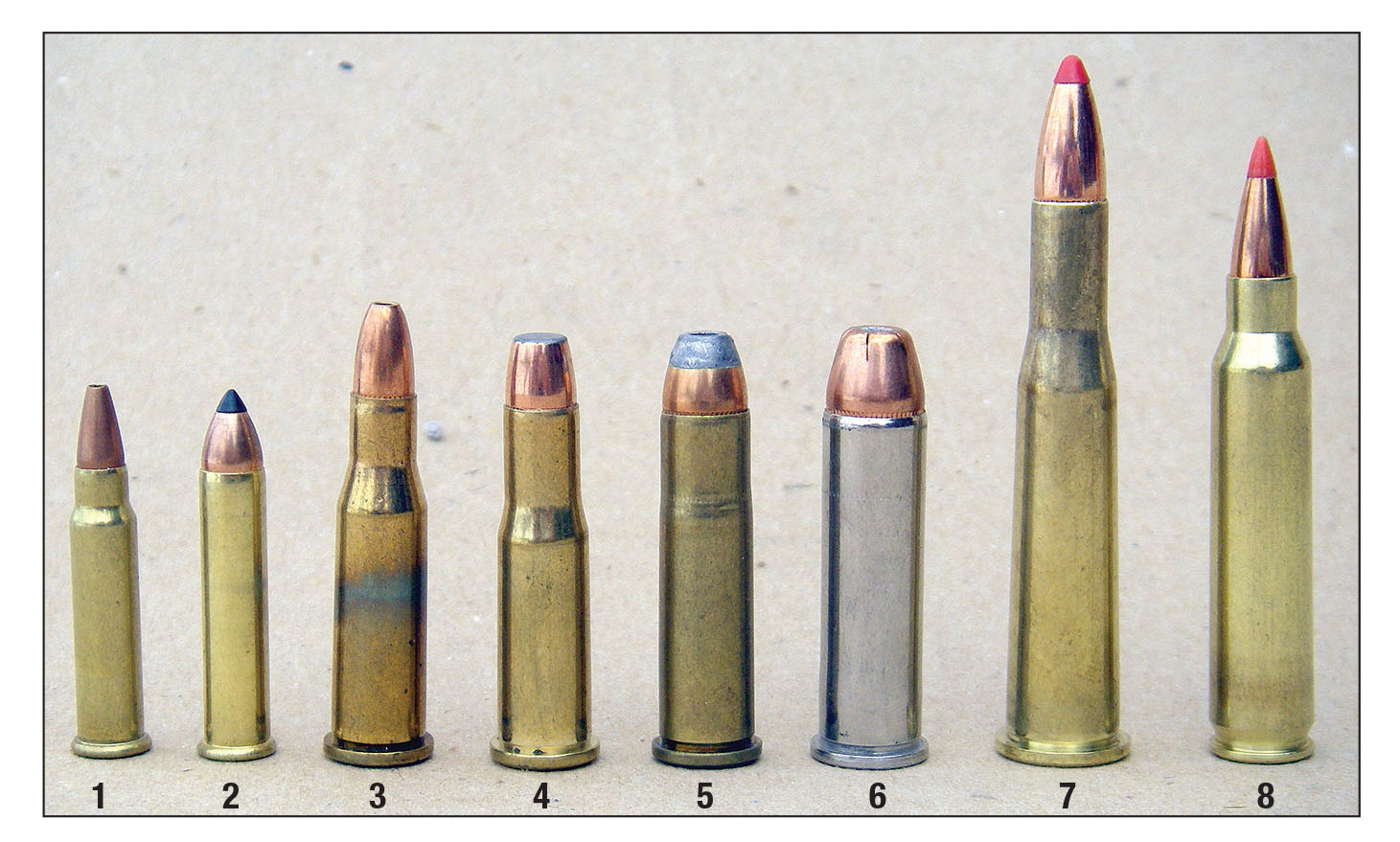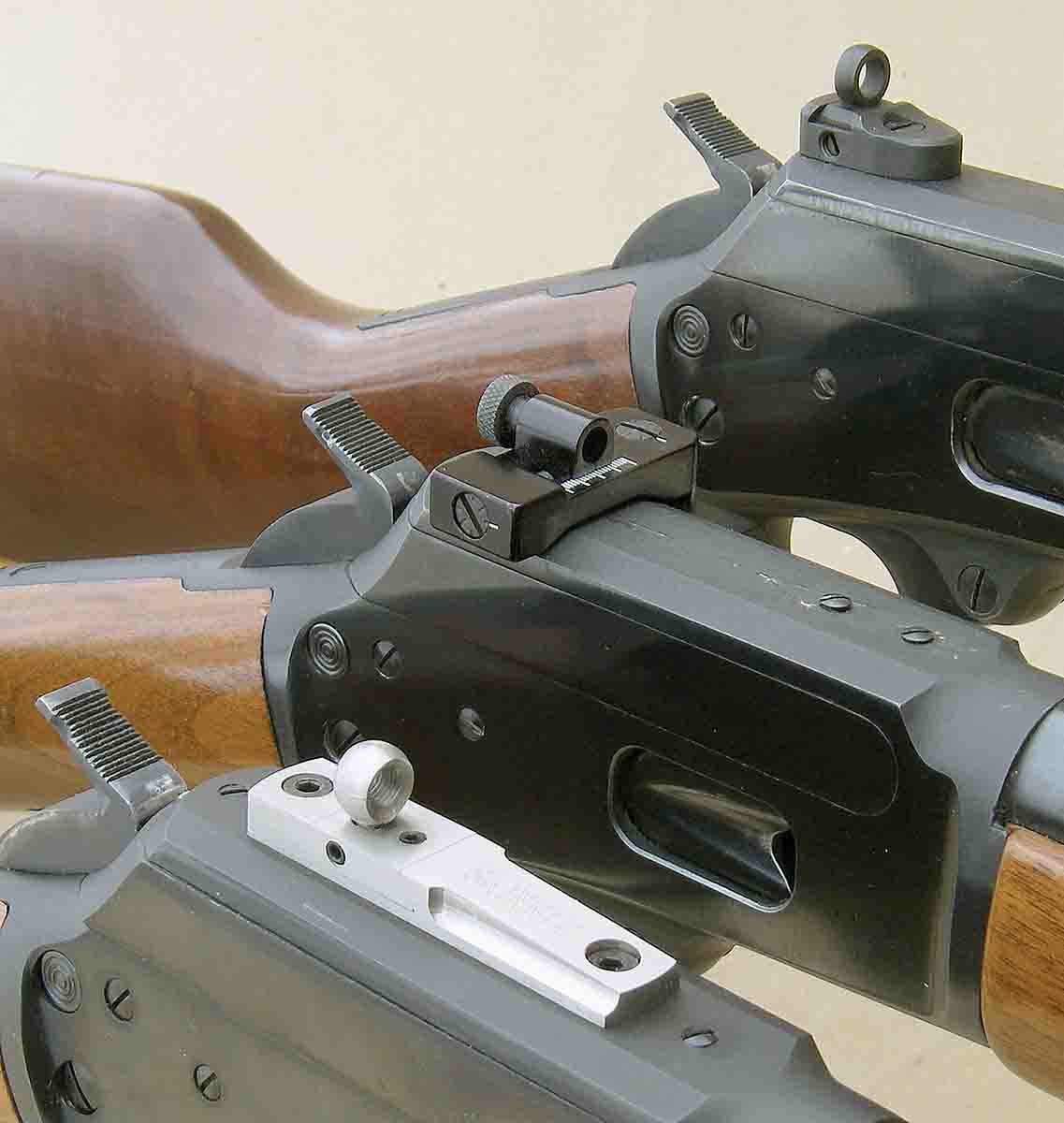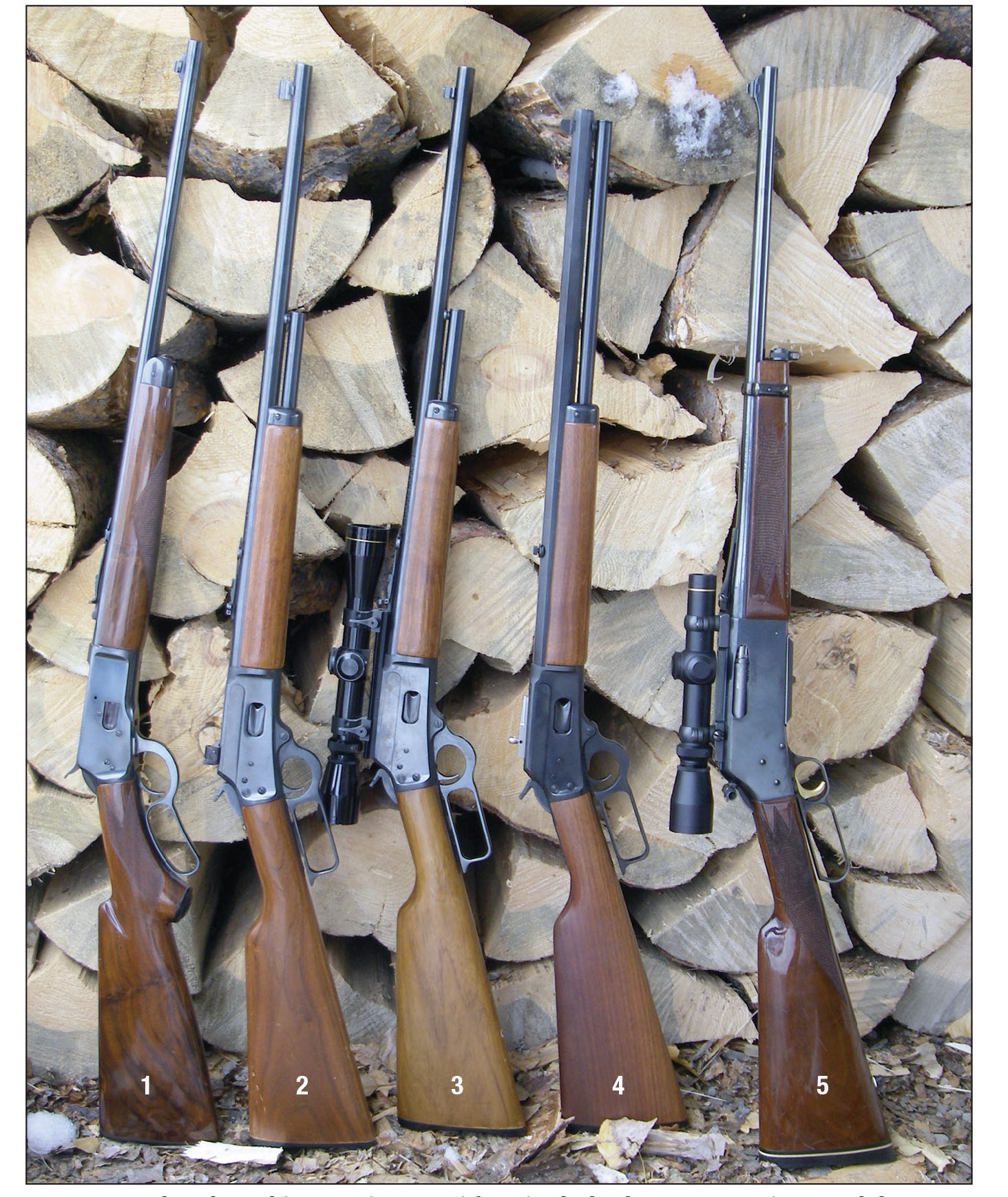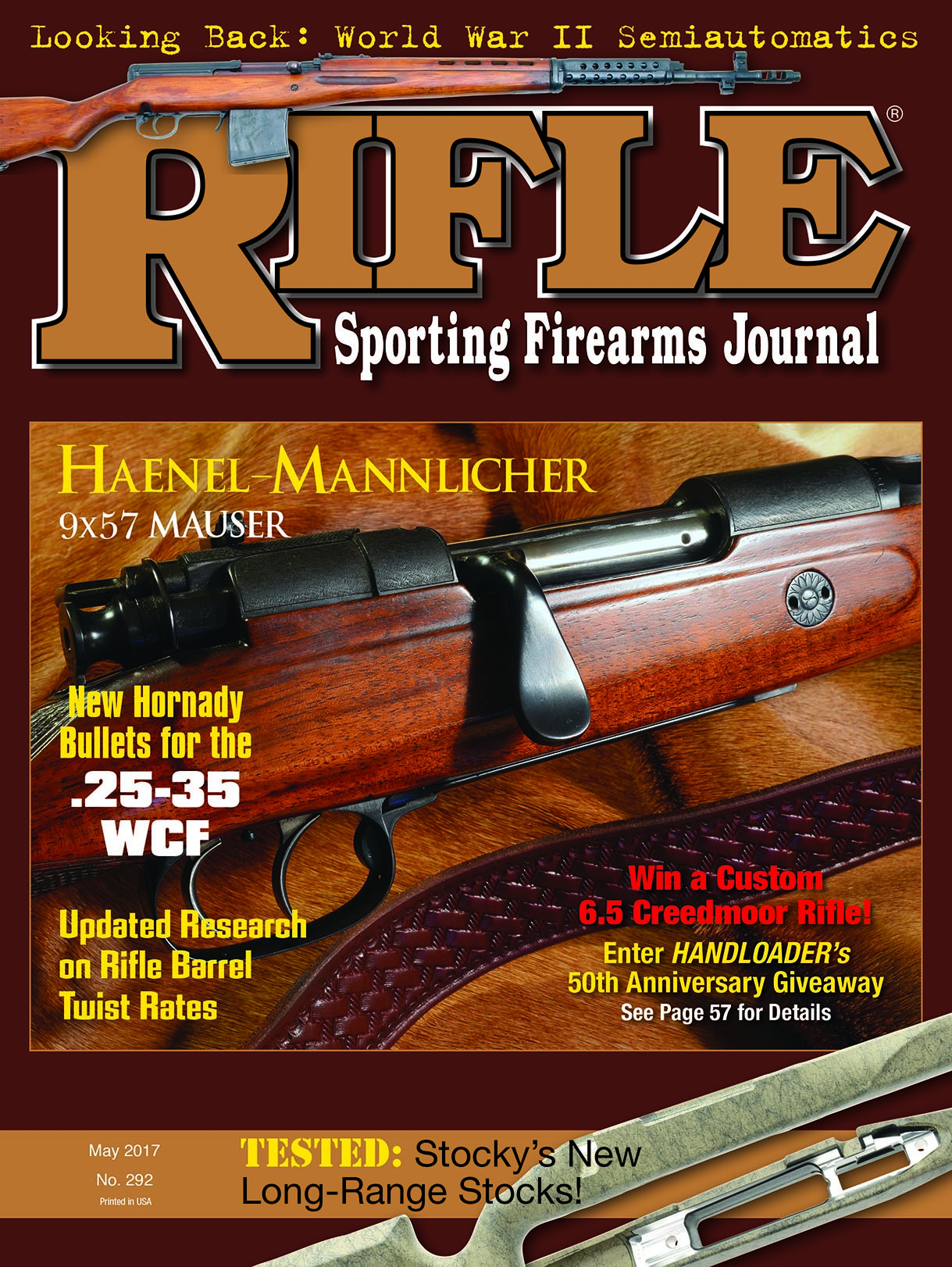Mostly Long Guns
Leverguns and Varmint Cartridges
column By: Brian Pearce | May, 17
Mention the term “varmint rifle,” and most shooters envision a heavy-barreled, bolt- action rifle in a flat-shooting, small-caliber cartridge. Leverguns, however, have been used for varmints and small-game hunting since the 1860s. They are not great choices for the varmint shooter firing a rifle from sandbag rests, as such rifles cannot be levered while resting on bags, and they require special technique and skill to shoot with top accuracy. That accuracy can rarely be compared to precision bolt rifles and cartridges. However, lever actions are excellent choices when calling coyotes where shot distances are close and shooting is often from a sitting position or offhand.

By 1882 the Winchester Model 1873 was chambered for the .32-20 (aka .32 WCF). This was a dedicated varmint cartridge of its day, although it was often pressed into service for hunting deer, and there are even accounts of it being used for self-defense and by period lawmen. Original loads pushed a 115- grain lead bullet 1,177 fps, although after the development of smokeless powder and stronger rifles, such as the Model 1892 Winchester and Marlin Model 1894, special “high velocity” loads were offered in 1914 that reached 1,640 fps. By 1923 Remington advertised an 80-grain hollowpoint, mushrooming bullet at 2,000 fps. Unfortunately, due to the many older rifles and revolvers in existence, those loads have been discontinued.
Today’s smokeless powder factory loads advertise a 100-grain lead bullet at 1,210 fps. When using modern rifles designed to handle handloads with similar pressures, such as the Winchester Model 1892/Model 92, Marlin Model 1894, Browning Model 53, etc., handloaders can easily duplicate those ballistics using magnum revolver powders and jacketed hollowpoint bullets from Hornady, Sierra and Speer. Such loads are devastating to varmints while offering mild recoil and a comparatively modest muzzle report. I have used handloads successfully many times on deer and similar game, but using correct bullets along with precise shot placement is crucial for absolute success.

Based on the .32-20 case necked down, the .25-20 Winchester was introduced in August 1895 for the Winchester Model 1892 rifle. Several other rifle manufacturers quickly offered guns, including Marlin and Remington. Townsend Whelen tested the .25-20 extensively and praised its virtues as a small-game and varmint cartridge. In 1972, Ken Waters stated in Handloader magazine, “In the first quarter of this [twentieth] century there wasn’t a finer combination small game and varmint cartridge for repeating rifles in existence.”
Original factory loads contained 17.0 grains of black powder and pushed an 86-grain lead bullet 1,376 fps. After suitable smokeless powders became available, the bullet was changed to jacketed, velocities were increased to 1,460 fps, and factories quickly offered “high velocity” loads that reached 1,732 fps. In the 1920s, a 60-grain load was also advertised at 2,200 fps. These loads were devastating on varmints but had no appeal for taking edible table fare, due to extensive destruction.
The .25-20 has always been known for its accuracy, with good rifles and loads often grouping within one inch. It offers a modest muzzle report, economical shooting (especially when handloaded), long barrel life and reliable performance. It may not offer as flat of a trajectory as the .22 Hornet, .218 Bee, .222 Remington, etc., but having shot a number of coyotes, foxes, rockchucks and other pests with it, I can say it absolutely hits harder – especially on the larger varmints with 60-, 75- and 86-grain bullets pushed at higher velocities. While I have vintage Winchester and Marlin leverguns, the one I use most is the Marlin 1894CL.
As can be read elsewhere in this magazine, Winchester offered the “smokeless” .25-35 cartridge in 1895 for the relatively new Model 1894 rifle. It was based on the same case as the .30-30 Winchester, and with bullet weights ranging from 60 to 117 grains, it was intended to serve as a dual-purpose cartridge for varmints and big game up to the size of deer. Like the .25-20, the .25-35 has always displayed excellent accuracy.
In years past I have handloaded the .25-35 with lightweight spitzer bullets, in an effort to improve ballistics and terminal performance on varmints, but would place a cartridge in the chamber and only one in the magazine tube to prevent possible primer detonation due to the pointed bullet profile. With the recent development of Hornady’s new 110-grain spitzer rubber-tipped FTX bullet at 2,425 fps, which performs well on varmints and deer and offers a comparatively flat trajectory, this practice is no longer necessary.

Winchester necked the .25-20 case down to .22 caliber, moved the shoulder forward to increase powder capacity and called it the .218 Bee. It became available in 1938 and was first offered in the Model 65 lever action – a Model 1892 var-iant. Pressures were bumped to 40,000 CUP, which drove the 46- grain bullet around 2,860 fps and allowed it to easily outrun the .22 Hornet. It has been suggested that the mediocre accuracy of the lever-action rifle limited the Bee’s popularity; Winchester soon offered it in the Model 43 bolt action, but sales were never as strong as those for the .22 Hornet. As more modern varmint cartridges began appearing with an emphasis on accuracy, increased velocities, stronger cases (.222 Remington, .223 Remington, .222 Remington Magnum, etc.), the Bee began slipping out of favor.
Regardless, the .218 Bee is fun and useful if kept within respected distance limits – generally around 200 yards or possibly a bit farther. A good levergun will group within 2 inches at 100 yards, and a select few rifles and loads will group inside one inch. Since it is based on the .32-20/.25-20 case, it will probably not slip into obsolescence anytime soon, with ammunition being produced as demand warrants.
While there are many lever-action cartridges suitable for hunting varmints, the focus here has been on small, light recoiling cartridges designed specifically for that purpose. With that thought in mind, the .357 Magnum, originally designed for sixguns in 1935 by Smith & Wesson and Winchester, is an outstanding multipurpose cartridge. It has been chambered in several excellent leverguns including the Marlin Model 1894 (in multiple variations), Winchester Model 94, Miroku/Winchester and Browning Model 92, Uberti Model 1873 and several additional imports.
The .357 typically pushes a 158- grain JHP bullet around 1,750 fps from a 20-inch rifle barrel, but loads from Buffalo Bore (and select handloads) can reach around 2,000 fps, which is quite effective on coyotes and smaller varmints. When shooting prairie dogs and ground squirrels, the impact of 158-grain JHP bullets from Hornady and Nosler is devastating. Recoil is certainly more noticeable than the previously discussed varmint cartridges, but it is still modest, and guns are easy to shoot accurately. Reliable hits can be made at 150 yards with good sights and an accurate rifle. On a good day, along with a dash of luck, it can take coyotes at 200 yards. The .357 Magnum is also a reliable cartridge for taking deer within its respected limits and delivers much greater terminal performance than its “paper” ballistics indicate. Over the years my family and I have taken many deer with .357 leverguns.
The Browning BLR rifle variants (and the long-discontinued Savage Model 99) have been available in modern varmint cartridges such as the .223 and .22-250 Remingtons, .243 Winchester, etc. I like the BLR for these cartridges, although it does not have a great trigger, and it’s difficult to reduce to a respectable light, crisp pull. Furthermore, while BLRs are accurate, they do not shoot as well as bolt-action varmint rifles. Nonetheless, the Browning is capable of taking varmints at greater distances than the previously mentioned traditional leverguns and is a good option if that is the goal.
Almost everyone loves a rimfire, with the .17 HMR and .22 WMR being excellent for hunting pests and smaller varmints. Both have been offered in leverguns from Winchester, Henry and even Marlin (.22 Magnum). These are so fun to hunt and plink with, they get shot a lot, making them less economical than originally hoped for! I prefer the .22 Winchester Magnum for foxes and coyotes, as it offers a larger caliber and heavier bullet, but it does not shoot as flatly. The .17 HMR is highly accurate, offers notably greater velocity and naturally shoots flatter, making it capable of taking ground squirrels and pests at 200 yards.
Leverguns are generally lightweight, compact, handy, easy to carry and allow rapid follow-up shots, and they are much more accurate than is commonly believed. For the outdoorsman, trapper or varmint hunter wanting an easy-to-carry rifle, they are uniquely American and are still top choices.


